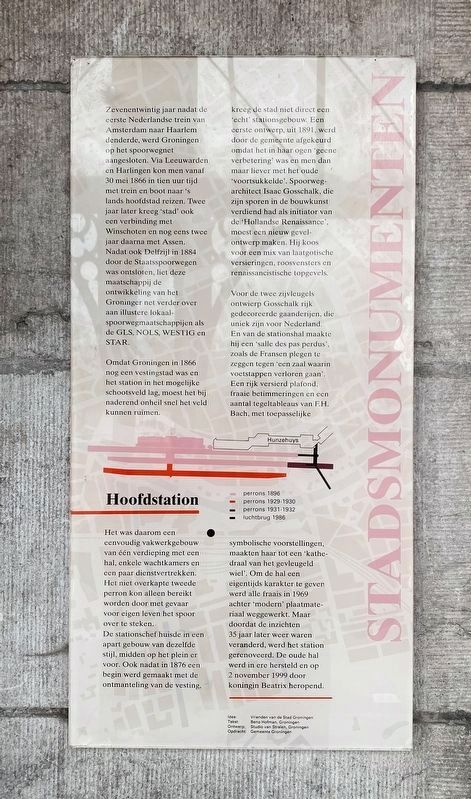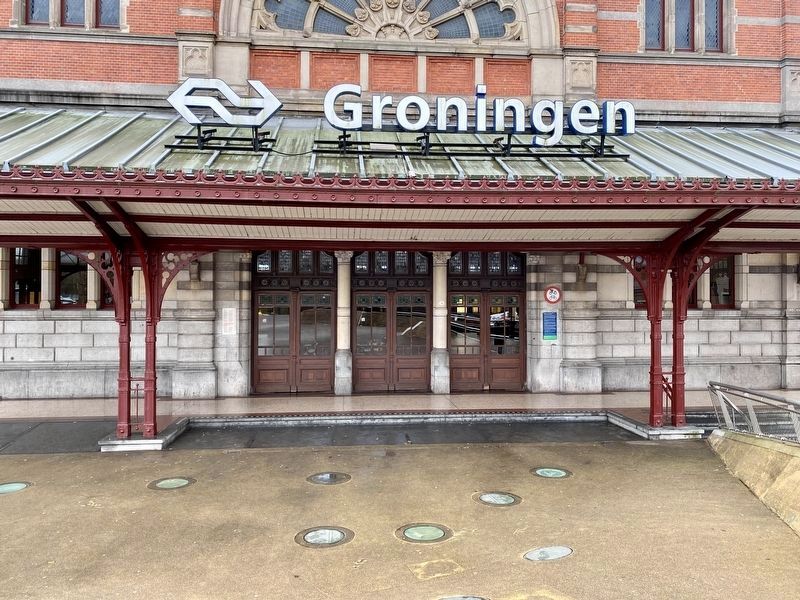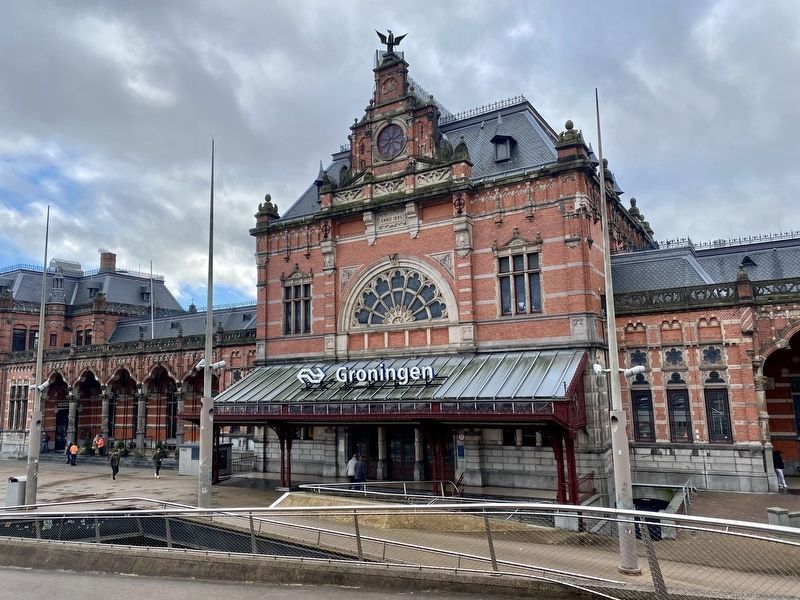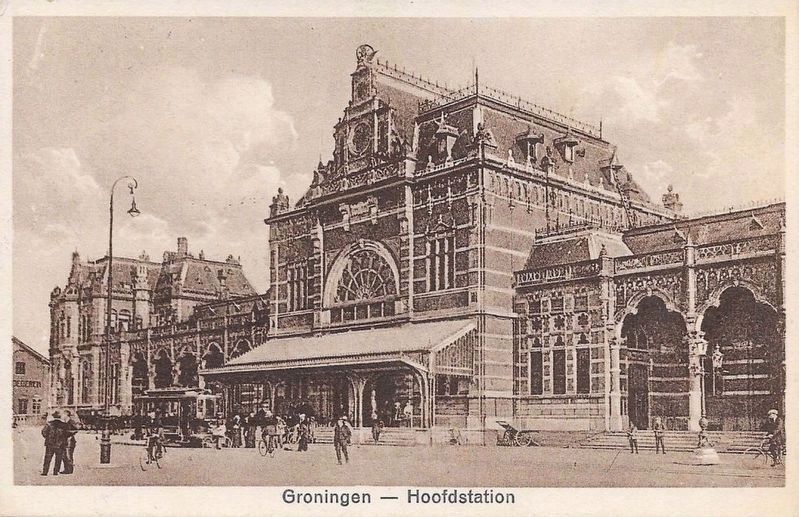Groningen, Netherlands — Northwestern Europe
Hoofdstation / Main Railway Station
— Stadsmonumenten —
Omdat Groningen in 1866 nog een vestingstad was en het station in het mogelijke schootsveld lag, moest het bij naderend onheil snel het veld kunnen ruimen. Het was daarom een eenvoudig vakwerkgebouw van één verdieping met een hal, enkele wachtkamers en een paar dienstvertrekken. Het niet overkapte tweede perron kon alleen bereikt worden door met gevaar voor eigen leven het spoor over te steken. De stationschef huisde in een apart gebouw van dezelfde stijl, midden op het plein ervoor. Ook nadat in 1876 een begin werd gemaakt met de ontmanteling van de vesting, kreeg de stad niet direct een ‘echt’ stationsgebouw. Een eerste ontwerp, uit 1891, werd door de gemeente afgekeurd omdat het in haar ogen ‘geene verbetering’ was en men dan maar liever met het oude ‘voortsukkelde’. Spoorweg-architect Isaac Gosschalk, die zijn sporen in de bouwkunst verdiend had als initiator van de ‘Hollandse Renaissance’, moest een nieuw gevelontwerp maken. Hij koos voor een mix van laatgotische versieringen, roosvensters en renaissancistische topgevels.
Voor de twee zijvleugels ontwierp Gosschalk rijk gedecoreerde gaanderijen, die uniek zijn voor Nederland. En van de stationshal maakte hij een ‘salle des pas perdus’, zoals de Fransen plegen te zeggen tegen ‘een zaal waarin voetstappen verloren gaan’. Een rijk versierd plafond, fraaie betimmeringen en een aantal tegeltableaus van F.H. Bach, met toepasselijke symbolische voorstellingen, maakten haar tot een ‘kathedraal van het gevleugeld wiel’. Doordat de hal in de jaren zestig werd gemoderniseerd, onder meer omdat de plafonds van papier-maché niet te restaureren bleken, is dit alles thans aan het gezicht onttrokken. De wachtkamers hebben daarentegen wel hun negentiende-eeuwse karakter bewaard.
Twenty-seven years after the first Dutch train from Amsterdam to Haarlem, Groningen was connected to the railway network. You could travel to
the capital via Leeuwarden and Harlingen in ten hours’ time with the train and boat from 30 May 1866 on. Two years later the ‘city’ received also a connection with Winschoten and again two years later with Assen. After that, Delfzijl was made accessible by the State Railways in 1884, this company left the development of the Groninger network to the illustrious local-railway companies, such as GLD, NOLS, WESTIG and STAR.
Since in 1866, Groningen was still a fortified city and the station was in a possible shootings area, it had to be cleared quickly when danger was coming. It was therefore a simple framed building consisting of one floor with a hall, some waiting rooms, and a couple of rooms for the service people. The not covered second platform could only be reached when crossing the platform with the fear of risking one’s own life. The station chief lived in a separate building with the same style, in front of the building. Also after that, in 1876, a start was made with the dismantling of the fortress, the city did not get directly a ‘real’ station building. The first design, from 1891, was rejected by the municipality, because it was in their eyes no improvement and they preferred then the old ‘trudged’ one. Railway-architect Isaac Gosschalk, who earned his proficiency in the building art as initiator of the ‘Hollands Renaissance’, had to draw a new design for the facade. He chose for a mix of Late-Gothic decorations, rose windows and top facades of the style of the Renaissance.
For the two side wings Gosschalk designed decorated arcades, which are unique for the Netherlands. And of the station hall he made a ‘salle des pas perdus’, as the French try to say ‘a hall in which footsteps get lost’. A richly decorated ceiling, fine panelling and a couple tile paintings of F.H. Bach, with applicable symbolic images, made it as a ‘cathedral of the winged wheel’. Because the hall got modernised in the sixties, for example, because the ceilings of paper-mâché were not able to be renovated, this all is now removed. The waiting rooms kept, although, their nineteenth-century’s character.
Erected by Gemeente Groningen. (Marker Number 15.)
Topics and series. This historical marker is listed in this topic list: Railroads & Streetcars. In addition, it is included in the Groningen Stadsmonumenten series list. A significant historical date for this entry is May 30, 1866.
Location. 53° 12.664′ N, 6° 33.845′ E. Marker is in Groningen. Marker is on Stationsplein, on the right when traveling west. Touch for map. Marker is in this post office area: Groningen 9726 AE, Netherlands. Touch for directions.
Other nearby markers. At least 8 other markers are within walking distance of this marker. De Toekomst / “The Future” (approx. 0.3 kilometers away); Ged. Zuiderdiep 96-98 (approx. 0.4 kilometers away); Hereplein 4-5 (approx. 0.4 kilometers away); Synagogue (approx. 0.4 kilometers away); Herestraat 106 (approx. half a kilometer away); Tuinkoepel Scholten (approx. half a kilometer away); Postkantoor/ Post Office (approx. 0.6 kilometers away); Evert Jan Thomassen à Thuessink (approx. 0.6 kilometers away). Touch for a list and map of all markers in Groningen.
Credits. This page was last revised on December 31, 2023. It was originally submitted on November 24, 2022, by Andrew Ruppenstein of Lamorinda, California. This page has been viewed 51 times since then and 6 times this year. Photos: 1, 2, 3, 4. submitted on November 24, 2022, by Andrew Ruppenstein of Lamorinda, California.



